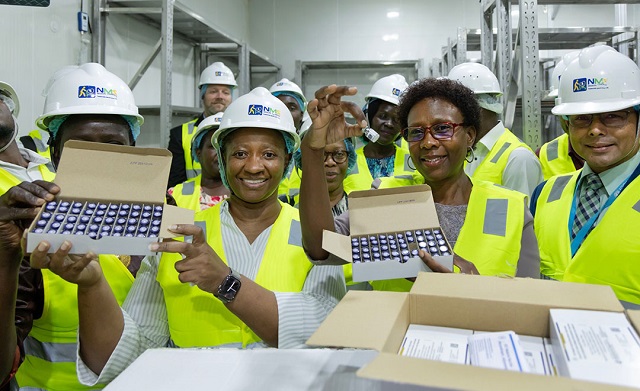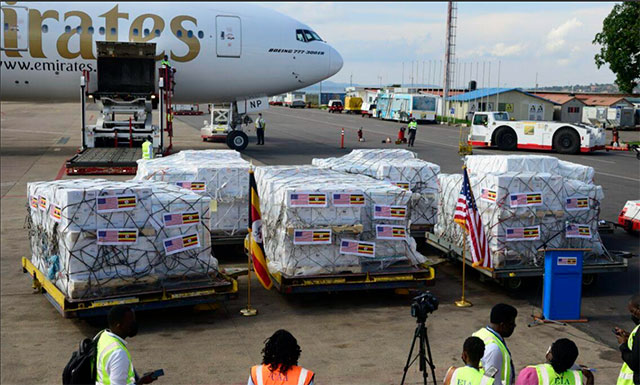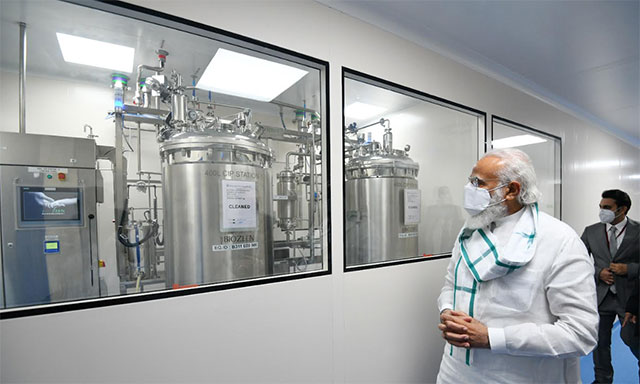
How should continental vaccine manufacturers handle complex dynamics of supply and demand?
ANALYSIS | The African Union has embarked on one of its most audacious health security missions: Ensuring that the continent manufactures 60% of its own vaccines by 2040. Africa currently manufactures a lowly 1% of the vaccines. However, since April 2021, when the AU tasked the Africa Centres for Disease Control and Prevention (Africa CDC) to initiate a structure, technocrats have been busy pushing the dream. In the last of our four-part series, The Independent’s Ronald Musoke looks at mechanisms that are being advanced to tackle the continent’s vaccine supply and demand challenges.
At the second ‘Vaccine and Other Health Products Manufacturing Forum’ held on Feb.4-6 in Cairo, Egypt, Dr Hisham Stait, the head of the Egyptian Unified Procurement Authority gave a rousing update on Africa’s ever-growing commitment to self-sufficiency in manufacturing of vaccines. “The target is not just a strategic ambition but a reflection of our sheer determination to create a resilient healthcare system,” he said.
Dr Stait referenced the African Union’s vision of producing 60% of Africa’s vaccine needs locally by 2040. “The journey toward self-sufficiency in vaccine and health products manufacturing is no longer a vision – it is a necessity inspired by the experience gained from the COVID-19 pandemic,” he said.
Egypt continues to lead in the transformation of vaccine production and procurement patterns on the continent. The North African country possesses nearly 20% of Africa’s vaccine manufacturing capacity and plans to produce 380 million doses annually in the next five years.
Dr Stait highlighted the unprecedented funding commitments made to support Africa’s health products manufacturing sector, including over US$5.5 billion in pledged investments. These commitments, he said, reflect global confidence in Africa’s capacity to produce high-quality health products, including vaccines.
The Cairo forum amplified the ongoing debate of the African Union’s stance of ramping-up of in-continent health products manufacturing, including vaccines. It noted how Africa continues to suffer outbreaks of Ebola, Mpox, cholera, Marburg, measles, and many others and carries a high burden of infectious diseases with millions of people continuing to suffer from ancient diseases such as tuberculosis, malaria and many others, each year.
According to a recent report by the Tony Blair Institute at the University of Oxford in the U.K, at least 10 million global deaths per year are attributable to diseases with existing or forthcoming adult vaccines and preventative injectable therapies.
The report shows that addressing these could offer more than US$ 3.4 trillion in value for the global economy, including US$1 trillion for developing countries and more than US$ 7 trillion in a pandemic scenario.
Reversing the trend
According to the World Economic Forum, the African market for vaccines and medicines is valued at over US$ 50 billion annually, yet the continent imports most of the healthcare products that it consumes. That includes 99% of vaccines.
At the Cairo Forum, Wamkele Mene, the Secretary-General of the African Continental Free Trade Area (AfCFTA), said Africa must reverse this trend. “This meeting provides an opportunity to refine our strategy, our plan, and our vision for regional manufacturing of essential health products in Africa, particularly in light of policy documents that support our goal of producing 60% of Africa’s vaccines by 2040,” said Mene.
However, there is also debate of how best the continent should ensure that investments being made don’t go to waste with white elephant projects littering the continent. There have also been arguments about whether ongoing investments in vaccine manufacturing plants around the continent are being done cognizant of existing market dynamics.

Expanding vaccine market
According to a brief by the Clinton Health Access Initiative (CHAI), an expanding global market for vaccines – with significant growth forecast for the African continent– means that there is potential to grow a thriving vaccine industry on the continent. The global non-profit that operates at the intersection between government, business and health, says the African routine vaccine market demand is, for instance, estimated to be worth US$ 1.3 billion annually.
Meanwhile, forecasts based on modelling undertaken by the non-profit show the potential for expansion of the African vaccine market across all existing and projected novel products to be somewhere between US$ 2.8 billion and US$ 5.6 billion within the next 15 years. In terms of the demand for vaccine doses, forecasts also suggest a growth of between 60% and 100%, from a baseline level of 1.3 billion doses in 2020.
Gavi’s role in procuring vaccines
Gavi, the Global Vaccine Alliance, is currently the largest single buyer of vaccines for use in Africa, with the vaccine alliance accounting for about half of the total market by value in 2020 and about one-third by volume.
Two decades of active market shaping by Gavi has seen expansion to long-term healthy market objectives, including fostering diversification, supply security, healthier demand and innovation.
This has resulted into an increase in the number of manufacturers supplying pre-qualified Gavi-supported vaccines, from five in 2001 to 18 in 2021 (with more than half based in Africa, Asia and Latin America). Prices for the most common vaccines for lower-income countries, already at a significant discount, have continued to decline.
Gavi has worked with the private sector to create favourable market conditions for the pharmaceutical industry to offer vaccines to lower-income countries at lower prices. This has been done by aggregating, pooling and financing demand to enable a layered or tiered pricing, whereby low-income countries are charged less than higher-income countries for the same or similar products. This has meant that lower-income countries such as Uganda now pay less for their routine vaccines than high-income countries.
Much of the remaining “non-Gavi” market share is accounted for by other pooled procurement, with alliance partner, UNICEF, responsible for managing perhaps as much as 90% of vaccine procurement in Africa by volume.
However, the proportion of vaccine doses consumed in Africa that are Gavi-supported is projected to fall significantly by 2040, largely as a result of countries transitioning from Gavi support to self-financing a greater proportion of their vaccine spend.
Experts at CHAI note that as unsubsidised demand becomes increasingly dominant, continued downward price-pressure will be critical if high levels of access are to be maintained across the continent.
This shows a critical role for all those involved, including the African Union, in shaping markets to ensure existing low-cost manufacturers remain viable, while at the same time, encouraging low-cost models of production on the African continent, notes the CHAI brief.
“We are very supportive of a vibrant, sustainable commercial vaccine sector on the continent. Africa’s aspirations for self-sufficiency in vaccine manufacturing can only be achieved with African leadership, full commitment, and stronger capacity on the continent,” Dr Sania Nishtar, the Chief Executive Officer of Gavi, said during the Cairo forum.
Dr Nishtar said it will take a multi-sectoral effort, with governments creating the right policy environment for manufacturers and investors to ensure the success of local vaccine manufacturing. She emphasised that governments must build the necessary capacity at the regulatory level, develop human resources, secure raw materials, sustain manufacturing and create appropriate demand in Africa. “When the next pandemic happens, we must make sure we are not at the end of the queue,” she said.
The Gavi model has country choice at its core, with African countries exercising product choice over approximately 700 million doses of vaccines worth about US$1 billion by 2030. Working closely with the African Union and implementing countries, it will be possible to send clearer demand signals to the market around the willingness of actors to select and procure from African suppliers.
Experts at CHAI say collective action could help provide an important signal of future demand to new manufacturers, while still being consistent with Gavi’s operating model and the principle of country choice. The experts say African countries themselves could, for example, provide new continental suppliers with increased demand assurances over the vaccines they intend to select through Gavi. “This would represent a significant volume of doses per year over the next 20 years.”
Potential business models
To capitalise on growth in the African market, there are potential models within which a sustainable industry could be established. These models, experts say, are not mutually exclusive, and all have implications for chosen antigens, technology platforms and requirements for support.
Some experts say a pragmatic pathway to sustainable expansion could be via the establishment of fill-finish capacity, with a view to adding bulk drug substance production over the near- or medium-term. In the long term, there could be scope for a broader number of smaller facilities focusing on novel antigens, pending technology transfer and regulatory approval arrangements.
Experts say one way of ensuring that vaccine manufacturers on the continent remain in business could be via focusing on establishing sterile ‘fill-finish’ capacity, with a pathway to enter one or more of the other models as regulatory systems, human resources capacity and technology transfer.
The other route, they argue, could be through focusing on not-yet-fully commoditised routine products such as HPV (Human Papillomavirus) vaccine, delivering improved product profiles, or delivering vaccines where improving market health is identified as a priority.
Another route could be via what they refer to as the “Platform Leapfrog model” where focus is on emerging platforms and novel products to position African manufacturing at the entry point to technologies likely to dominate future market expansion.
Focusing on mRNA-based antigens or novel vaccines in the pipeline such as HIV or next-generation TB and malaria vaccines could be one case in point. They also suggest the “Outbreak Focused model” which focuses on Africa-specific outbreak products for stockpile demand, such as the Multivalent Ebola, OCV (Oral Cholera Vaccine) and, Yellow Fever.
Matching industry capacity, priority antigens and market needs
At the Cairo forum, Dr Stait noted that in order to ensure commercial viability of the vaccine manufacturing industry on the continent, the capacity of the nascent industry must be matched with priority antigens and market needs.
He praised the launch of the African Pooled Procurement Mechanism (APPM), highlighting its transformative impact on market sustainability and demand certainty. By consolidating procurement across Africa, the APPM intends to enable manufacturers to scale production, advancing Africa’s self-sufficiency in vaccine and health product manufacturing. “Our role extends beyond unified procurement; we foster economic growth, sustainability, and local industrial innovation,” said Dr. Stait.
Experts note that an examination of the current landscape of new initiatives shows the need for more work to ensure investments are coordinated, focused on priority antigens, and underpinned by evidence-based business planning. This kind of approach could guide investors to focus on gaps in the market, and provide insights into how purchasers are thinking about likely future demand dynamics.
For example, with the recent global oversupply of COVID-19 vaccines, basing new sustainable businesses on these antigens alone presents an uncertain commercial proposition. Any prequalified or suitably authorised COVID-19 vaccine manufactured in Africa would be eligible for Gavi support. But, given the time and investment required to establish new facilities, the uncertain market for future COVID-19 vaccines, a foundation of routine vaccine production may provide a more viable business model.
Focus on antigens or mNRA technology?
It is also not yet known whether mRNA technology will be a preferable platform for routine vaccines. While there is a case for building capacity based on an mRNA technology leapfrog model, an alternative may be to focus on antigens where there is a clear market health need for additional manufacturers on the continent.
This would maximise the potential for near- to medium-term sustainability. On the other hand, where new entrants meet priority market health needs, opportunities to build sophisticated and coordinated support to these entrants is maximised. Gavi alongside CHAI have analysed potential antigens for prioritisation through the lense of market health and market shaping needs. Preliminary results have shown that commercial sustainability and market health can be maximised by focusing on priority antigens where new manufacturers are most beneficial to markets.
According to a 2023 joint assessment done by the Africa CDC, CHAI and PATH on current and planned vaccine manufacturing in Africa, dynamic market circumstances notwithstanding, priority antigens might include, what the experts referred to as “Group A” antigens for vaccines such as oral cholera, measles-rubella, yellow fever, malaria and Ebola-Zaire. The production of these would be done with the view of improving the global market health.

“Group B” category could include antigens with opportunities for enhanced product profiles, for example, through enhanced thermostability, smaller packaging, higher efficacy, higher valency, longer duration of protection or better tolerability. These may include rotavirus, pneumococcal, human papillomavirus, meningococcal, oral cholera, and novel malaria vaccines.
For “Group C” vaccines, current analysis indicates that new suppliers may undermine global market health and there is little space for new entrants to operate sustainably (pentavalent vaccines, inactivated polio,typhoid conjugate, and Japanese encephalitis).
In the “Group D” category are the longer-term variety where there may be significant opportunities linked to novel vaccines or unaddressed diseases yet to complete trials, or receive regulatory authorisation, or be widely adopted. These include Respiratory Syncytial Virus (RSV), novel TB, Ebola Sudan or even HIV.
This group may also include priority pathogens in which CEPI (the Coalition for Epidemic Preparedness Innovations) is already investing, including Lassa Fever, Chikungunya, Rift Valley Fever (RVF), Nipah virus, and MERS (Middle East Respiratory Syndrome), plus others identified by the WHO as having pandemic potential, including influenza.
In addition to antigen selection for commercial sustainability and market health, a ‘pandemic dividend’ for Africa requires that these also span different technology platforms. This could ensure the ability to flexibly scale production in the event of a pandemic according to need.
However, experts at CHAI note that the pathway from increased manufacturing to an industry that is pandemic-response ready, is not straightforward, with a number of dependencies beyond manufacturing that must also be addressed. Even for vaccines with significant existing market potential, broader support to the enabling environment will be a critical determinant of success.
Finding a new business model
Experts at CHAI say manufacturers entering (or expanding within) the market in Africa will need to identify strategies that enable them to co-exist with suppliers offering low-cost vaccines. The new entrants will in particular need to find a way to position their products alongside those offered by established manufacturers, especially those from Asia that already supply over 50% of WHO-prequalified vaccines.
New modelling indicates that in any scenario, products from new entrants in Africa can be expected to come at a cost premium, at least in the near term. Some market analysts have suggested that new entrants might struggle to find a pathway to sustainable production and make their investments viable.
New mechanisms must therefore be found to support new entrants, while at the same time, avoiding a situation in which incumbent manufacturers increase their prices for vaccines due to lost volumes. This, vaccine market analysts warn, could carry a potential risk of increasing the costs of immunisation on the continent.
The analysts point to the past where, whenever this path has been taken in some countries, the effort and financing required to establish new vaccine manufacturing infrastructure and human capacity has often been significant. The analysts argue, it is likely this would be no different for new entrants in Africa.
Going forward, it will be important to focus on the dual goals of maintaining global supplier diversity and supply resilience. For example, while high-volume India-based vaccine production has revolutionised access to certain routine vaccines, the export restrictions that were put in place during the early stages of the COVID-19 pandemic significantly affected vaccine deliveries to lower-income countries.
The experts at CHAI argue that such scenarios make a strong case for viewing regional diversity in the supplier base and regional supply security as important attributes of a healthy vaccine market.
“In general, each new vaccine and most major new manufacturing facilities have required some level of external intervention to reduce risk to private sector investment and meet the needs of vaccine equity,” the assessment reads in part.
“The same will be true in terms of securing pandemic vaccine supply resilience via regional manufacturing in Africa, with support required spanning capital investment, revised offtake arrangements and investment in the enabling environment.”
According to the assessment, it is likely that success will require incentive structures to shape and stimulate support and de-risk investment. “This could be the potential role of an updated, highly targeted, and bold market shaping strategy, underpinned by substantial support from Gavi, to deliver a new era of African vaccine manufacturing.”
****
This article is made possible by the African Union Media Fellowship program, which is implemented by the African Union (AU) through the Information and Communication Directorate and supported by the European Union (EU). Its content is the sole responsibility of the journalist and does not necessarily reflect the views of the AU or the EU.
 The Independent Uganda: You get the Truth we Pay the Price
The Independent Uganda: You get the Truth we Pay the Price



